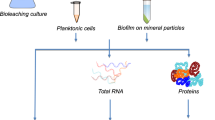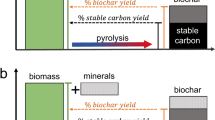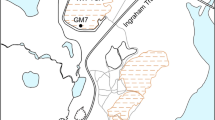Abstract
Microbes are playing increasingly important roles in commercial mining operations, where they are being used in the “bioleaching” of copper, uranium, and gold ores. Direct leaching is when microbial metabolism changes the redox state of the metal being harvested, rendering it more soluble. Indirect leaching includes redox chemistry of other metal cations that are then coupled in chemical oxidation or reduction of the harvested metal ion and microbial attack upon and solubilization of the mineral matrix in which the metal is physically embedded. In addition, bacterial cells are used to detoxify the waste cyanide solution from gold-mining operations and as “absorbants” of the mineral cations. Bacterial cells may replace activated carbon or alternative biomass. With an increasing understanding of microbial physiology, biochemistry and molecular genetics, rational approaches to improving these microbial activities become possible
This is a preview of subscription content, access via your institution
Access options
Subscribe to this journal
Receive 12 print issues and online access
$209.00 per year
only $17.42 per issue
Buy this article
- Purchase on Springer Link
- Instant access to full article PDF
Prices may be subject to local taxes which are calculated during checkout
Similar content being viewed by others
References
Australian Mineral Foundation. 1993. “Biomine '93” Proceedings of the International Conference and workshop on Applications of Biotechnology to the Minerals Industry. Adelaide, South Australia, March 22-23, 1993.
Australian Mineral Foundation. 1994. “Biomine '94” Proceedings of the International Conference and workshop on Applications of Biotechnology to the Minerals Industry. Perth, West Australia, 1994.
Torma, A.E., Wey, J.E., Lakshmanan, V.I., Apel, M.L., Brierley, C.L. (Eds.). 1993. Biohydrometallurgical Technologies, Volume I, Bioleaching Processes, 769 pp.; and Volume II, Fossil Energy Materials, Bioremediation, and Microbial Physiology, 794 pp. The Minerals, Metals & Materials Society, Warrendale, PA.
Ehrlich, H.L. and Brierley, C.L. (Eds.). 1990. Microbial Mineral Recovery, 454 pp. McGraw-Hill, New York.
Barrett, J., Hughes, M.N., Karavaiko, G.I. and Spencer, P.A. 1993. Metal Extraction by Bacterial Oxidation of Minerals, 191 pp. Ellis Horwood, New York.
Livesey-Goldblatt, E., Norman, P. and Livesey-Goldblatt, D.R. 1983. Gold recovery from arsenopyrite/pyrite ore by bacterial leaching and cyanidation, p. 627–641. In: Recent Progress in Biohydrometallurgy. Rossi, G. and Torma, A.E. (Eds.). Azzociazione Mineraria Sarda, Iglesias, Italy.
van Aswegen, P.C., Haines, A.K. and Marais, H.J. 1988. Design and operation of a commercial bacterial oxidation plant at Fairview. Randol Perth Gold 88, pp. 144–147.
Aswegen, P.C., Godfrey, M.W., Miller, D.M. and Haines, A.K. 1991. Developments and innovations in bacterial oxidation of refractory ores. Minerals and Metallurgical Processing 8: 188–192.
Aswegen, P.C. and Haines, A.K. 1988. Bacteria enhance gold recovery. International Mining. May issue, pp. 19–23.
Kelly, D.P. 1988. Evolution of the understanding of the microbiology and biochemistry of the mineral leaching habitat, p. 3–14. In: Biohydrometallurgy-87. Norris, P. R. and Kelly, D. P. (Eds.). Science and Technology Letters, Kew, Surrey, UK.
Harrison, A.P. 1984. The acidophilic Thiobacilli and other acidophilic bacteria that share their habitat. Annu. Rev. Microbiol. 38: 265–292.
Karavaiko, G.I., Golovacheva, R.S., Pivovarova, T.A., Tzaplina, I.A. and Vartanjan, N.S. 1988. Thermophilic bacteria of the genus Sulfobacillus, p. 29–41. In: Biohydrometallurgy-87, Norris, P. R. and Kelly, D. P. (Eds.). Science and Technology Letters, Kew, Surrey, UK.
Norris, P.R. and Parrott, L. 1986. High temperature, mineral concentrate dissolution with Sulfolobus, p.355–365. In: Fundamental and Applied Biohydrometallurgy. Lawrence, R. W., Branion, R. M. R. and Ebner, H. G. (Eds.). Elsevier, Amsterdam.
Woese, C.R. 1987. Bacterial evolution. Microbiol. Rev. 51: 221–271.
Torma, A.E. 1986. Biohydrometallurgy as an emerging technology, p. 49–63. In: Biotechnology Engineering Symposium, Vol. 16. Ehrlich, H. L. and Holmes, D. S. (Eds.). John Wiley and Sons, New York.
McCready, R.G.L. 1988. Progress in the bacterial leaching of metals in Canada, p. 177–195. In: Biohydrohydrometallurgy-87, Norris, P. R. and Kelly, D. P. (Eds.). Science and Technology Letters, Kew, Surrey, UK.
DiSpirito, A.A. and Tuovinen, O.H. 1982. Uranous ion oxidation and carbon dioxide fixation by Thiobacillus ferrooxidans. Arch. Microbiol. 133: 28–32.
Kelly, D.P., Norris, P.R. and Brierley, C.L. 1979. Microbiological methods for the extraction and recovery of metals, p. 263–308. In: Microbial Technology: Current State, Future Prospects. Bull, A. T, Ellwood, D. C. and Ratledge, C. (Eds.). Cambridge University Press, Cambridge, UK.
Dew, D.W., Miller, D.M. and van Aswegen, P. C. 1993. GENMIN's commercialization of the bacterial oxidation process for the treatment of refractory gold concentrates. Randol Gold Forum, Beaver Creek, 7–9 September, pp. 229–237.
Chapman, J.T., Marchant, P.B., Lawrence, R.W. and Knopp, R. 1993. Biooxidation of a refractory gold bearing high arsenic sulphide concentrate: a pilot study. FEMS Microbiol. Rev. 11: 243–252.
Brierley, C.L. 1990. Bioremediation of metal-contaminated surface and groundwaters. Geomicrobiol. J. 8: 201–223.
Whitlock, J.L. and Smith, G.R. 1989. Operation of Homestake's cyanide biodegradation wastewater system based on multi-variable trend analysis, p. 613–625. In: Biohydrometallurgy-1989. Jackson Hole, Wyoming.
Rawlings, D.E., Mjoli, N.M. and Woods, D.R. 1991. The cloning and structure of genes from the autotrophic biomining bacterium Thiobacillus ferrooxidans, p. 215–237. In: Advances in Technology, Vol. 2. Greenaway, P. J. (Ed.). JAI Press Ltd, London.
Rawlings, D.E. and Woods, D.R. 1995. Developing of improved biomining bacteria, p. 63–84. In: Bioextraction and Biodeterioriation of Metals. Gaylarde, C. and Videla, H. (Eds.). Cambridge University Press, Cambridge,UK.
Kusano, T., Sugawara, K., Inoue, C., Takeshima, T., Numata, M. and Shiratori, T. 1992. Electrotransformation of Thiobacillus ferrooxidans with plasmids containing a mer determinant. J. Bacteriol. 174: 6617–6623.
Peng, J.-B., Yan, W.M. and Bao, X.-Z. 1994. Plasmid and transposon transfer to Thiobacillus thiooxidans. J. Bacteriol. 176: 2892–2897.
Jin, S.M., Yan, W.-M. and Wang, Z.N. 1992. Transfer of IncP plasmids to extremely acidophilic Thiobacillus ferrooxidans. Appl. Envir. Microbiol. 58: 429–430.
Peng, J.-B., Yan, W.-M. and Bao, X.-Z. 1994. Expression of heterogenous arsenic resistance genes in the obligately autotrophic biomining bacterium Thiobacillus ferrooxidans. Appl. Envir. Microbiol. 60: 2653–2656.
Rawlings, D.E. and Kusano, T. 1994. The molecular genetics of Thiobacillus ferrooxidans. Microbiol. Rev. 58: 39–55.
Inoue, C., Sugawara, Shiratori, K., Kusano, T. and Kitagawa, Y. 1989. Nucleotide sequence of the Thiobacillus ferrooxidans chromosomal gene encoding mercuric reductase. Gene 84: 47–54.
Inoue, C., Sugawara, K. and Kusano, T. 1991. The regulatory gene of Thiobacillus ferrooxidans is spaced apart from the mer structural genes. Molec. Microbiol. 5: 2707–2718.
Kusano, T., Takeshima, T., Inoue, C. and Sugawara, K. 1991. Evidence for two sets of structural genes coding for ribulose bisphosphate carboxylase in Thiobacillus ferrooxidans. J. Bacteriol. 173: 7313–7323.
Kusano, T., Takeshima, T., Sugawara, K., Inoue, C., Shiratori, T., Yano, T., Fukumori, Y. and Yamanaka, T. 1992. Molecular cloning of the gene encoding Thiobacillus ferrooxidans Fe(II) oxidase. J. Biol. Chem. 267: 11242–11247.
Lane, D.J., Harrison, A.P. Jr., Stahl, D., Pace, B., Giovannoni, S.J., Olsen, G.J. and Pace, N.R. 1992. Evolutionary relationships among sulfur- and iron-oxidizing eubacteria. J. Bacteriol. 174: 269–278.
Sugio, T., Domatsu, C., Munakata, O., Tano, T. and Imai, K. 1985. Role of a ferric reducing system in sulfur oxidation of Thiobacillus ferrooxidans Appl. Environ. Microbiol. 49: 1401–1406.
Cervantes, C., Ji, G., Ramírez, J.L. and Silver, S. 1994. Resistance to arsenic compounds in microorganisms. FEMS Microbiol. Rev. 15: 355–367.
Silver, S. and Walderhaug, M. 1992. Gene regulation of plasmid- and chromosome-determined inorganic ion transport in bacteria. Microbiol. Rev. 56: 195–228.
Silver, S., Budd, K., Leahy, K.M., Shaw, W.V., Hammond, D., Novick, R.P., Willsky, G.R., Malamy, M.H. and Rosenberg, H. 1981. Inducible plasmid-determined arsenate, arsenite and antimony(III) in Escherichia coli and Slaphylococcus aureus. J. Bacteriol. 146: 983–996.
Rawlings, D.E., Pretorius, L.-M. and Woods, D.R. 1984. Construction of arsenic-resistant Thiobacillus ferrooxidans recombinant plasmids and the expression of autotrophic plasmid genes in a heterotrophic cell-free-system. J. Biotechnology 1: 129–133.
Silver, S., Ji, G., Bröer, S., Dey, S., Dou, D. and Rosen, B.P. 1993. Orphan enzyme or patriarch of a new tribe: the arsenic resistance ATPase of bacterial plasmids. Molec. Microbiol. 8: 637–642.
Author information
Authors and Affiliations
Corresponding authors
Rights and permissions
About this article
Cite this article
Rawlings, D., Silver, S. Mining with Microbes. Nat Biotechnol 13, 773–778 (1995). https://doi.org/10.1038/nbt0895-773
Issue Date:
DOI: https://doi.org/10.1038/nbt0895-773
This article is cited by
-
The contribution of living organisms to rock weathering in the critical zone
npj Materials Degradation (2022)
-
Space station biomining experiment demonstrates rare earth element extraction in microgravity and Mars gravity
Nature Communications (2020)
-
Multimetal bioremediation and biomining by a combination of new aquatic strains of Mucor hiemalis
Scientific Reports (2019)
-
Assessment of Fish Embryo Survival and Growth by In Situ Incubation in Acidic Boreal Streams Undergoing Biomining Effluents
Archives of Environmental Contamination and Toxicology (2019)
-
Research progress in biohydrometallurgy of rare metals and heavy nonferrous metals with an emphasis on China
Rare Metals (2016)



